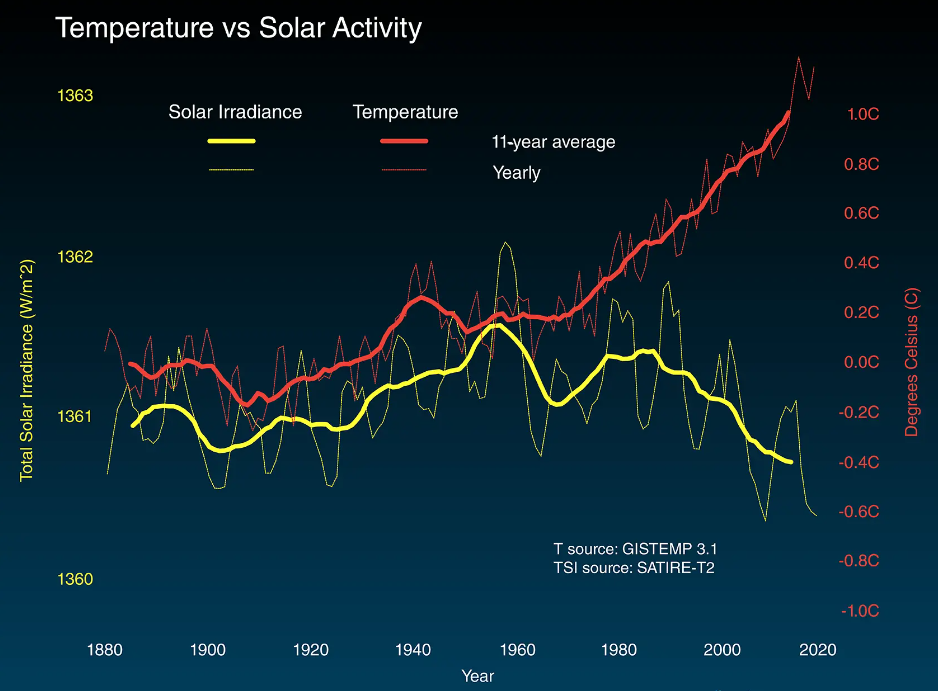Introduction
The relative importance of natural vs human factors has been a frequent topic of debate in recent talks about climate change. Talking to those dubious about humans’ role in climate change requires you to approach the conversation with decency and sensitivity (Skeptical Science). The graph (NASA) shows variations in the Earth’s surface temperature as a function of solar radiation received by the planet. Let us delve into the argument that solar activity drives global warming, a myth that scientific observations have debunked.
Debate Sides
Certain deniers of climate change contend that variations in solar activity, as opposed to human actions, are to blame for the present global warming patterns. The historical relationship between solar activity, such as sunspots, and Earth’s climate supports this argument. However, this viewpoint needs to be revised when examining evidence from the past few decades on climate. Furthermore, the ability to distinguish between anthropogenic effects and natural variability has improved due to advances in climate research.
The opposing viewpoint I have selected to address claims that “It’s the sun” is to blame for the planet’s recent warming (Skeptical Science). According to this viewpoint, the sun’s natural 11-year cycle of solar irradiance variance significantly influences Earth’s climate. Nevertheless, data from scientific studies show that Earth’s climate and solar irradiance have been moving in different directions over the past 35 years (NASA). The primary suspects in this mismatch are greenhouse gasses, which imply the presence of additional causes.
Graphic Arguments
Global temperatures, represented by red lines on the accompanying graph, and solar irradiance, defined by yellow lines, clearly diverge (NASA). The 11-year averages are displayed with annual changes, allowing the underlying trends to be seen by removing short-term variance. In contrast to the rising global temperatures, the 11-year average of solar irradiance does not indicate any net increase since the 1950s (NASA). Debunking the claim that solar activity is the leading cause of the current climate change requires using this visual evidence. This shows how solar changes are insufficient to explain the observed warming.
Counterargument
A contrarian might make the case for solar activity in a simulated debate, to which the answer would focus on the data shown in the graph (NASA). While acknowledging that nature has a role in climate change, it is critical to stress that the evidence does not support the notion that these factors are the main drivers of the current warming trend. Civil conversation can frequently highlight the details that are missed in divisive arguments. Moreover, combining data from several sources, such as ice core samples and satellite measurements, enhances the case for artificial global warming.
Data Presentation to a Wider Audience
The public’s interpretation of the data is just as important in the discourse surrounding climate science as the data itself. Communicators of climate science are concentrating more and more on how to accurately and understandably communicate complicated scientific concepts to a lay audience. Dispelling common misconceptions, including the notion that climate change has always happened naturally, is part of this. It also explains why human activity is the primary cause of the current changes, which differ in their breadth and rapidity. In order to fully comprehend and accept climate change, it is also necessary to address its psychological and emotional components, which frequently act as roadblocks.
A skeptic can argue that historical relationships between solar cycles and climate provide proof of the sun’s power. The increased influence of carbon emissions caused by humans, which has been shown in recent studies, is frequently ignored in such arguments. This, however, ignores the strong evidence that the rise in temperature in the second half of the 20th century and beyond is unrelated to solar activity. Maintaining this position shows a selective reading of the existing data in science. This error emphasizes how important it is for those discussing climate dynamics to be well-versed in science.
Additionally, although it is a consoling narrative, the scientific community has overwhelmingly supported the opposite view, which holds that climate change is part of normal variability. Misinformation plays a part in the lack of public concern for anthropogenic global warming, making addressing it more urgent than needed. As such, the job of climate science communicators goes beyond simply disseminating information; it also entails crafting narratives that convey the seriousness of the issue, its moral ramifications, and the necessity for community action to slow down and adapt to climate change. Arming individuals with information and optimism is the key to changing public opinion and promoting significant action.
Conclusion
Misconceptions about climate change have a substantial influence on policy and individual behavior. Therefore, it is essential to have an informed conversation outside of academic circles. Thus, knowing the scientific details and having the ability to interact with various audiences are both necessary for effective communication regarding climate change. In order to create an informed community that is prepared to take action, the data and graph that have been mentioned can be used as tools to bridge the gap between the technical aspects of climate research and the general public.

Works Cited
NASA. “Graphic: Temperature Vs Solar Activity – Climate Change: Vital Signs of the Planet.” Climate Change: Vital Signs of the Planet, 2020. Web.
Skeptical Science. “Arguments From Global Warming Skeptics and What the Science Really Says.” Skeptical Science, 2023. Web.